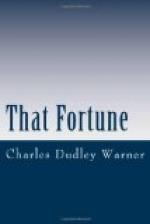It was a gay world up here among the tossing branches. Across the river, on the first terrace of the hill, were weather-beaten farmhouses, amid apple orchards and cornfields. Above these rose the wooded dome of Mount Peak, a thousand feet above the river, and beyond that to the left the road wound up, through the scriptural land of Bozrah, to high and lonesome towns on a plateau stretching to unknown regions in the south. There was no bar to the imagination in that direction. What a gracious valley, what graceful slopes, what a mass of color bathing this lovely summer landscape! Down from the west, through hills that crowded on either side to divert it from its course, ran the sparkling Deerfield, from among the springs and trout streams of the Hoosac, merrily going on to the great Connecticut. Along the stream was the ancient highway, or lowway, where in days before the railway came the stage-coach and the big transport-wagons used to sway and rattle along on their adventurous voyage from the gate of the Sea at Boston to the gate of the West at Albany.
Below, where the river spread wide among the rocks in shallows, or eddies in deep, dark pools, was the ancient, long, covered, wooden bridge, striding diagonally from rock to rock on stone columns, a dusky tunnel through the air, a passage of gloom flecked with glints of sunlight, that struggled in crosscurrents through the interstices of the boards, and set dancing the motes and the dust in a golden haze, a stuffy passage with odors a century old—who does not know the pungent smell of an old bridge?—a structure that groaned in all its big timbers when a wagon invaded it. And then below the bridge the lad could see the historic meadow, which was a cornfield in the eighteenth century, where Captain Moses Rice and Phineas Arms came suddenly one summer day to the end of their planting and hoeing. The house at the foot of the hill where the boy was cultivating his imagination had been built by Captain Rice, and in the family burying-ground in the orchard above it lay the body of this mighty militia-man, and beside him that of Phineas Arms, and on the headstone of each the legend familiar at that period of our national life, “Killed by the Indians.” Happy Phineas Arms, at the age of seventeen to exchange in a moment the tedium of the cornfield for immortality.
There was a tradition that years after, when the Indians had disappeared through a gradual process of intoxication and pauperism, a red man had been seen skulking along the brow of this very hill and peering down through the bushes where the boy was now perched on a tree, shaking his fist at the hated civilization, and vengefully, some said pathetically, looking down into this valley where his race had been so happy in the natural pursuits of fishing, hunting, and war. On the opposite side of the river was still to be traced an Indian trail, running to the western mountains, which the boy intended some time to follow; for this highway of warlike forays, of messengers of defiance, along which white maidens had been led captive to Canada, appealed greatly to his imagination.




